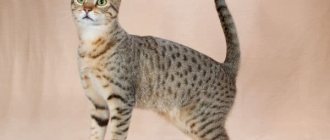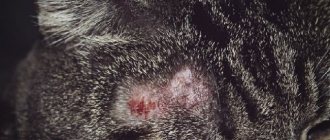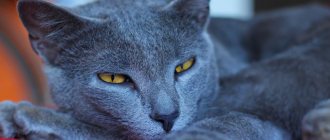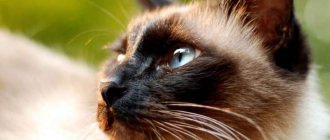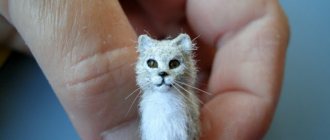The Cymric cat breed is native to the Isle of Man in Ireland. According to the generally accepted opinion, the tailless gene appeared among island cats as a result of a natural mutation. Whether this is true or not is difficult for us to judge, because many years have passed. It is known that these cats appeared in America in 1963, but this breed became popular in the 1970s. The name of the breed comes from Cymru, the Welsh name for Wales. The name of the breed was given by the breeder Blair Wright, his grandmother said that she saw these tailless cats in places in Wales. DescriptionCharacterCare
History of the origin of the breed
Historically, the Cymric and Manx breeds originated on the Isle of Man, located in the Irish Sea off the coast of Great Britain. A distinctive feature of these animals is the complete absence of a tail. Sometimes, as a joke, local residents call them a cross between rabbits and cats.
It is believed that Manx and Cymric are descendants of Far Eastern cats brought to the island by English sailors back in the 16th century.
Tailless pets are one of the attractions of Great Britain, there are even coins with their image.
The absence of a tail is a spontaneous gene mutation that arose more than four hundred years ago, apparently due to inbreeding within a limited area of the island.
Geneticists call such deviations the “bottleneck effect.” But in one litter kittens with different appendage lengths can be born. Therefore, this feature is now maintained thanks to the breeding work of breeders.
In addition to the absence of a tail, Welsh cats also have other developmental defects inherent in the mutated M gene. In offspring with two dominant genes of the MM type, complete non-viability is noted - the embryos are mummified at the stage of development in the womb of the female.
Kittens with mixed heredity of the Mm type survive and grow safely. Therefore, it is very difficult to get a full-fledged healthy Welsh tailless cat.
Usually breeding of two standard Cymrics or Manxes is not allowed by breeders. The second partner is most often a British Shorthair cat or a Stumpy cat with a tail of normal length.
The development of the Cymrik as a breed began in the sixties of the last century, when long-haired tailless kittens came to Canada. However, not all felinological systems recognize this variety.
Pros and cons of the breed
| Peculiarities | pros | Minuses |
| Appearance | pretty appearance, fluffy, soft fur, “rabbit” body | — |
| character | friendly cats, kind, accommodating, mischievous | dependent on the owner, may feel lonely |
| Content | Cymriki are unpretentious in keeping, feeding is the same as for other cats | a cat needs a lot of attention |
| Breeding | — | it is difficult to find a partner for breeding, there can only be up to 3 kittens in a litter |
| Health | Cymrics can be called long-livers; with good care they live up to 15–16 years | there is a tendency to serious genetic diseases that can lead to the death of the animal |
| Acquisition | you can easily find a Cymric cross born from a Manx | a purebred Cymrik can cost up to $1 thousand |
Breed standard
The most common description of Cymric is that adopted by the American international system TICA.
Head
In the shape of a modified rounded wedge with well developed cheekbones, cheek pads and whisker pads. The forehead is smoothly outlined, rounded. A profile with a slight stop on the bridge of a medium-sized nose. The chin is quite formed.
Eyes
Large, almost round, located at a slight angle with the outer corner raised up. The color always matches the coat color. Widely spaced. A narrower arrangement is considered a disadvantage, but is acceptable.
Ears
Medium size, moderately spaced. Wide at the base, tapering to rounded tips. Heavily pubescent on the inside and along the outer edge, there may be tassels.
Body
Strong and squat build. Cabby hull size is medium. The neck is short and powerful. Strong bones with athletically developed muscles. The back is round, the belly is small.
A graceful physique is considered a fault, but is not a reason to disqualify a cat.
Paws
Strong, powerful, medium length. The hind ones are slightly longer than the front ones. Between the large and wide pads there is an edge.
Insufficient length of the hind legs is a disadvantage, but not a reason for removing the animal from the exhibition.
Tail
Ideally, it is completely absent. Let's assume a small appendage (cartilage or vertebra) that cannot be felt by the hand and does not protrude beyond the croup.
Wool
The length of the main hair is medium. Powerful undercoat, thanks to which the coat is perceived as double.
Usually there are small “pants” on the hind legs and a “collar” on the neck and chest. The structure is delicate and silky. It is permissible to change the length and texture depending on the season.
Color
Almost everything is allowed, including randomly located white spots and medallions.
Weight
Medium sized cats. Tendencies towards dimorphism. An adult female weighs 3.5 - 5 kilograms, a male - 4-6 kilograms.
Matings
To obtain viable offspring, matings with individuals with a tail and out-of-breed crossings, usually with British Shorthair cats, are permissible.
Disqualification criteria
A cat is excluded from participation in the exhibition and breeding work if it has the following shortcomings:
- congenital eye deformities;
- body structure defects;
- polydactyly;
- cryptomorphism;
- weakness of the hind limbs.
Playful and affectionate
The voice of a Cymric is practically inaudible to the average ear. These cats are not capable of shrill screaming at the top of their voices, demanding food or attention.
However, gentle, flexible creatures are very capricious. They don't like to be cuddled by children. The family member who brought them into the house becomes their owner. They are especially affectionate and friendly with him.
Even man’s most faithful friend, the shepherd dog, can envy the Cymric’s devotion. Kymrik is so attached to his owner that he can become depressed when separated from him for a long time.
What are the benefits of grooming animals?Ultrasound of animals. Why is it made?
- Where can I take veterinary courses and what are they for?
Cymric kittens are playful and cute. Since childhood, these cats have shown one of their very interesting character traits and behavior. They hide their toys - balls, feathers, and are even capable of stealing pencils or other stationery items.
Another distinctive feature: these cats love to swim. If you teach your baby to do this from childhood, an adult pet will never give up water procedures.
Cats are bathed if necessary. For example, after a grand renovation in the house or an unsuccessful walk in the mud. But some breeders like to do this monthly to keep the animal's coat smooth, shiny and beautiful.
Veterinarians do not interfere with this decision. The main thing is that the cat doesn’t mind.
Four types of Cymric tailless cats
Since in one litter there may be kittens not only with long and short hair, but also with different tails, they are divided into the following types based on the latter characteristic
Rumpy
The name comes from the English word rumpy. These animals are distinguished by the complete absence of a tail, sometimes there is even a depression in its place.
For this reason, rampies are rated highest in the show and breed class. They are the ones who most often win prizes at felinological exhibitions.
Rampy riser
Rumpy-risers have a short appendage instead of a tail. It consists of three or four vertebrae covered with hair.
A sign that such a cat is allowed to compete is the length of the growth.
If, in a standing position, the modified tail does not reach the hand when stroking the animal on the back, admission is allowed.
Stumpy
This type of Cymric has a short tail, usually with defects - knots and creases. Such animals are suitable only as pets; they are not allowed for show or breeding.
Longs
Longi has a tail of normal length. If it is free of defects, then the pet is often used in the breeding program.
If there are knots and kinks, breeders dock the tail within a week of birth and sell the cat as a pet. Such animals are not allowed to participate in exhibitions.
Nature of Shorttails
Mentions of this breed date back to the end of the 18th century. The Isle of Man is very small and none of the cats that lived on it in those days had a long enough tail. Almost all pets were tailless.
During the evolution of the breed, the tail remained short, and the coat remained thick and long. It's all about the climate. Not to say that it is very harsh, but the undercoat was very useful for these cats in the cold season.
Everyone is used to seeing dark gray, “marbled” and silver-gray cats of this breed. But there are also red Cymrics, as well as cream colored ones. They are very beautiful. In addition, they have a very learned appearance and are calm.
You can admire a photo of the Cymrik cat below. The most striking varieties of colors with characteristics characteristic of the breed are presented.
Welsh cat colors
According to TICA standards, the following colors of Cymric are allowed:
- pure white with blue, topaz or heterochromic eyes;
- blue with green and topaz eyes;
- solid black – amber and emerald eyes;
- red (red);
- cream;
- silver chinchilla;
- smoky (silver, silver-black or blue);
- tabby (blue, silver, red, brown, mackerel);
- bi-colors (harlequin, tabby with white spots);
- cake
All colors, except the first three, can have any eyes - green, amber, aquamarine. Blue - only when white predominates.
Chocolate, lavender and Himalayan colors are not allowed on Cymrik.
Sections of the site
- Aquarium fish
- Aquarium fish: for beginners
- Aquarium fish: viviparous
- Aquarium fish: golden
- Aquarium fish: other
- Aquarium fish: carp
- Aquarium fish: large
- Aquarium fish: labyrinthine
- Aquarium fish: unusual
- Aquarium fish: iris
- Aquarium fish: catfish
- Aquarium fish: characins
- Aquarium fish: cichlids
- Amphibians
- Cats
- Crustaceans
- Reptiles
- Dogs
- Dogs: Bichons
- Dogs: Fighting
- Dogs: Greyhounds
- Dogs: Hounds
- Dogs: for children and companions
- Dogs: Indoor and decorative
- Dogs: large breeds
- Dogs: Pointers
- Dogs: small breeds
- Dogs: Molossians and Mastiffs
- Dogs: Shepherds
- Dogs: hunting
- Dogs: Herding
- Dogs: Pinschers
- Dogs: Spaniels
- Dogs: medium breeds
- Dogs: Terriers
- Snails
- Aquarium care
- Spitz
Contact with the administration: c
Mr. Cat Recommends: The Character of Cymric
Kymrik has a calm and balanced temperament. But at the same time, the muscular body of an athlete requires an active lifestyle. Young animals play with pleasure.
The lack of a tail is compensated by strong hind legs, thanks to which the pets are unusually jumping and easily overcome any height.
These animals are real intellectuals. They are easy to learn, able to remember a dozen commands, and open and close any door. Often, like dogs, they bury and hide their favorite toys and treats.
If you are accustomed to a harness as a child, they will happily walk with the owner.
These amazing animals are not at all afraid of water and swim with pleasure. They are rather silent and communicate with people using a kind of purring.
They are pathologically attached to their owner and suffer from separation. In terms of the degree of adoration for “their person,” they are more reminiscent of dogs than cats. They easily get along with children and other pets and never show aggression.
The long residence of this natural breed in a limited area made Cymric an excellent hunter. If a cat suspects a threat from another person directed at its owner, it will immediately attack. Therefore, the pet is initially distrustful of new faces in the house.
In his presence, it is not recommended to raise your voice, behave aggressively or be overly emotional.
In addition, it is an excellent mousetrap. In all other respects, Kimrik is quite balanced and stress-resistant. Ideal for those who love to travel. This pet easily endures any road - both a comfortable ride in a car and the hardships of long walks. He will follow the owner on his heels.
Appearance
Do you want to know what a male and female Cymrik looks like? Adult females reach a weight of 4.5 kilograms. Males weigh no more than 6. Their common features: roundness, large eyes, widely spaced ears.
The coat of representatives of this breed is not very long, but thick and voluminous. Cats have well-developed muscles, they are quite large, but at the same time compact.
The color can be very different. The red Cymric is the most common. The following color variations may also be present:
- chocolate,
- lavender,
- combined with white.
Based on the length of the tail, Cymrics are divided into 4 types:
- Longs. The tail is of standard length and is docked a few days after birth.
- Stumpy. There is a tail, but it is very short.
- Rampy riser. The short stub of the tail consists of only a few vertebrae.
- Rumpy. The most valuable species, since its tail is completely absent.
Health, maintenance and care
Cymrik's thick double coat requires special care - he needs to be brushed twice a week to prevent the formation of tangles. During the molting period - preferably every day.
There is no need to bathe your pet, only in case of severe contamination.
Nails should be trimmed weekly, sometimes more often. In Kymrik they grow very quickly - apparently the genetic memory of the hunting animal is at work.
These active animals require a balanced, high-calorie diet. If pets are fed natural food, their diet must include raw meat. Dry ready-made food is suitable at least premium class.
Taillessness entails many associated genetic diseases. Usually no more than two or three kittens are born alive in a litter. During the first month of life, they may develop Manx syndrome. It consists of severe damage to the spinal column and spinal cord. Such offspring are not viable and require euthanasia.
If the kitten has successfully grown to six months, then it will be a strong and healthy animal.
The structural features of the skeleton require careful treatment of this pet. The area in his tail area is very painful; under no circumstances should you spank him, even jokingly. When lifting Kymrik in your arms, you need to support him under his hind legs so as not to overload his spine.
Nutrition
Animals have an excellent appetite, and if the dosage of portions is not calculated, cats can become obese. It is best to feed premium ready-made food. You can feed both dry and wet food or alternate. From natural food, it is forbidden to give poultry or fish bones, fatty, smoked and sweet foods.
The stomach of Cymrik cats is not able to digest milk. If you feed natural products, you should periodically feed them with vitamins and other supplements so that your pets receive all the necessary microelements. When you give your cat ready-made food, additional vitamins are not needed.
Note! Adult cats should be fed 2 times a day, pregnant females and small kittens up to 5 times a day.
Cost of a kitten
The main rule for Manx and Cymrik lovers is to buy kittens only from foreign nurseries, with a full package of documents, checking the pedigree and health of the parents. Otherwise, there is a danger of acquiring ordinary yard cats with docked tails.
You can pick up a kitten only after six months - by this time it will be obvious that the threat of the animal being affected by Manx syndrome has passed.
The cost of kittens varies greatly depending on a number of factors: tail length, gender, pedigree, color, individual characteristics of individuals. The usual price in American, English and Canadian nurseries is from 300 to 1,000 US dollars.
1111
How much does Cymric cost, and where can I buy it?
It is extremely difficult to purchase a Cymric kitten in Russia , since there are no nurseries in the country that breed this breed.
The Cymrik breed is not recognized as independent by all felinological associations. Some organizations (such as the CFA) consider the Cymric to be a longhaired variation of the Manx. Abroad, the minimum cost of a pet-class Cymric at the age of three to four months starts from $350 US, show-class kittens cost $1000-1200 US, and sometimes more. The price is influenced by the appearance of the kitten (including the length of the tail); compliance with the standard; origin of the cat; services provided by the nursery; breeding costs; the country in which Cymric is purchased; sex and age of the animal.
If you want to buy a Cymric kitten, it is recommended to start looking for a cattery in the UK or USA. Before making a transaction, it is advisable to thoroughly check the reputation of the nursery and not buy Cymric from unregistered breeders.
Stock images from Depositphotos





